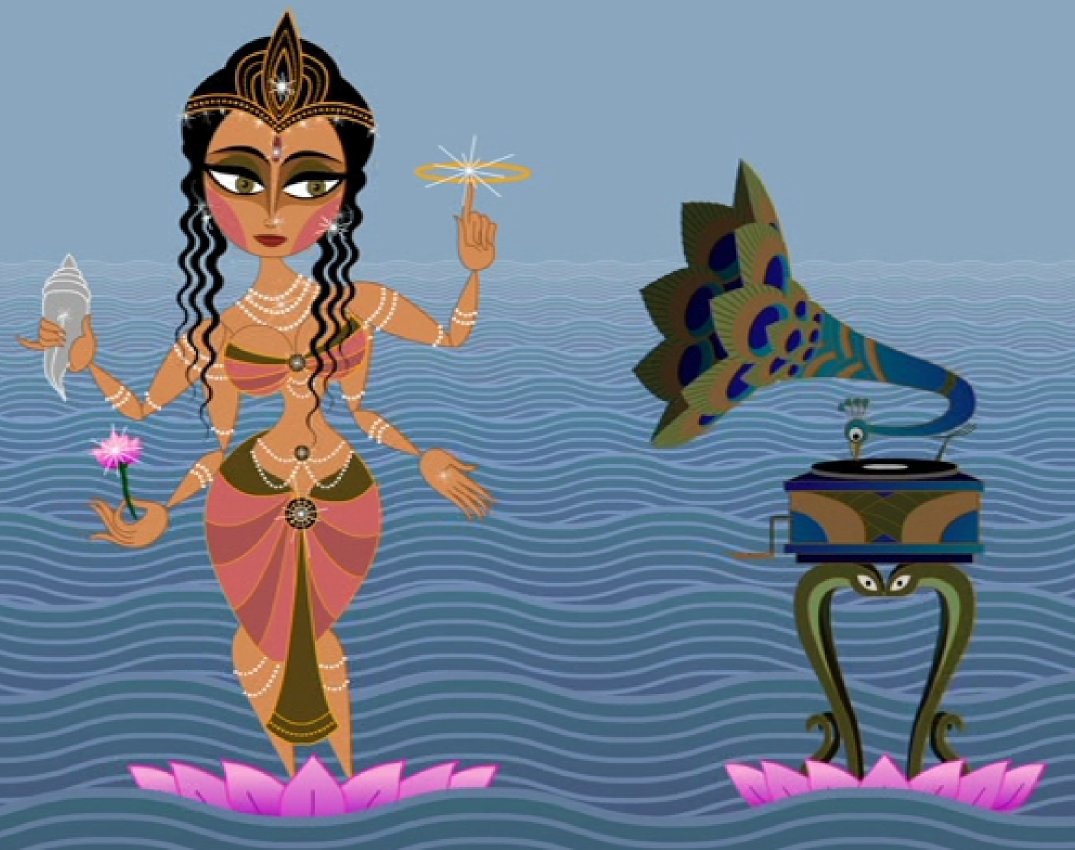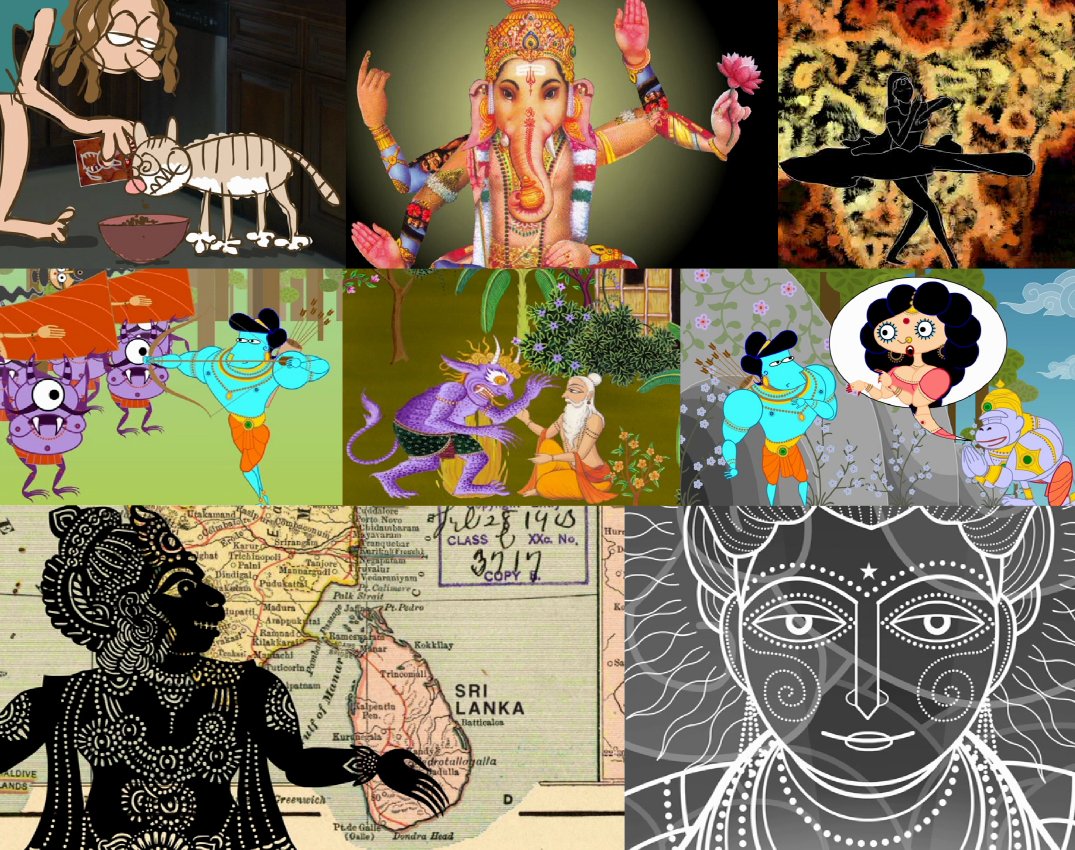"Sita Sings The Blues" by self-taught animator Nina Paley, may be the first feature-length animated film released under a free license (the Creative Commons By-SA). Presented through a variety of animation styles and narrative tones, it fuses apparently disparate ideas and sources into a unified whole. An ancient Hindu epic, The Ramayana, is retold largely through the songs of a 1920s American singer, Annette Hanshaw. The mode of storytelling also mirrors aspects of the world-wide collaborative potential of twenty-first century art, reflected also in the film's real life controversies, including copyright entanglements and censorship concerns.
When Nina Paley was reeling from the pain of a failed marriage, she did what any good artist should do: she turned her pain into art by creating Sita Sings the Blues. She apparently did not have any plans to create a free-licensed film, but her experience in publishing her project made her into a believer.

The central magic of the film is the mixture of two cultural artifacts that helped her through her problems: the ancient Hindu epic, The Ramayana, and the songs of American singer Annette Hanshaw. Through the lens of her own experience, she saw parallels between the emotional tone of the songs and the plight of one of the Ramayana's more controversial characters, Sita -- the "perfect woman" that Rama (the "perfect man") finds he must give up in order to be a "perfect ruler".
The original point of the story is presumably that leadership makes extreme personal demands and requires men to give things up that they would never do if they could serve their own needs. In the original, therefore, Sita is little more than a prop for the story of Rama's devotion to his duty. But this work has been very controversial and troublesome for modern faithful women in India, and has been the subject of much rationalization and interpretation.
Paley made the work her own, focusing almost entirely on this aspect of the story, and how Sita's feeling paralleled her own feelings of abandonment in her divorce. As with any good Hindu story, there isn't exactly a moral -- just a lot of extremities of feeling and action, leaving you to draw out your own meaning.
This in itself is controversial, simply because Paley is not an Indian or even Indian-American woman, but a White American of Jewish descent. For some, this kind of international reinterpretation of a deeply revered work amounts to some form of cultural imperialism. Others applaud the freedom and perspective to be found in mixing works on an international level.
My own impressions
I was very impressed. Reading the descriptions, I was a little worried that the frame story would bother me -- it's usually not a great idea for an artist to put herself in as a character (especially in such an emotionally-sticky situation). But it was done very tastefully, with the appropriate detachment, so that Nina the character is quite distinct from Nina Paley, the animator. There is also no jarring introduction of live-action film in an animation -- Nina and Dave are represented in a sketchy, stylized collage of animation that makes their story a little generic and abstract. This serves to universalize the tale.

The storytelling in the film is done by three "shadow puppets" whose voices are actually those of three of Nina Paley's Indian-American friends discussing and trying to remember the story details of the Ramayana in an unscripted interview session. Paley notes that the three come from different parts of India, and so have heard different versions of the stories or different interpretations of them. Thus, this mode of storytelling emphasizes the role of oral tradition and interpretation in how people relate to these ancient epics (even though the works themselves are written).

This approach meshed well with the collage of differing animation styles mapped to variations of the narrative with their different tones. A collage style illustrates the (sometimes comic) mismatching of the discussed story points, while a more traditional style of drawing is associated with a somewhat flippant, but basically direct telling of the story. Finally, there are the musical numbers done in a style reminiscent of 1920s animation (like "Betty Boop"), with the voice of Annette Hanshaw representing Sita.
These interpretations demonstrate the malleability of stories and the need to re-interpret and "re-mix" them to mesh with our daily lives in an era which is, after all, immensely different from the one in which Valmiki wrote down the Ramayana. So it seems very appropriate for such a work to be released under a free-license, so that it too can be re-mixed and re-interpreted by its viewers.
International fusion
I must confess I was not familiar with the Ramayana (beyond knowing it existed), so this film is my first impression of it. Some of the people for whom this work is a holy writ find such an irreverent treatment of its content offensive. Some see its production by an American in terms of some sort of cultural imperialism (though, ironically, that term is usually applied to the imperialist's cultural works being imposed on other cultures, rather than the other way around).

I think both opinions are fundamentally unfair and short-sighted. Myths belong to everyone -- that's what gives them value. Whether the myth has any historical truth in it is almost irrelevant -- the truth of such stories is internal. Taking any work too seriously causes us to disconnect it from our daily lives and makes it less relevant. So I think it's very useful to apply our day-to-day sensibilities even to works we otherwise consider sacred.
As a closer-to-home example, one of my favorite interpretations of Revelations (which has got to be the weirdest product of the Christian religion, IMHO), was made by a Japanese animator (Hideaki Anno). I've cursed Neon Genesis Evangelion for having a lousy ending and other narrative flaws, but it was a stylistically fascinating external look at the Christian apocalypse myth. Indeed it really made me think about the fact that I come from a culture which has an apocalypse myth -- how weird and scary must that seem to the Japanese that we have the end of the world all planned out in our mythology?

Sita Sings the Blues is not simply a version of the Ramayana. It is a work that incorporates elements of the Ramayana and fuses them with elements of American culture and elements of the artist's life. It is really an original work which strongly references and interprets the Ramayana. Paley describes it as "her Ramayana", as opposed to "the Ramayana." These works are the beginnings of a new, more international, culture composed from the elements of the past, but speaking to new generations of viewers.
In interviews from her website and on the DVD, Paley notes that free-licensing her movie makes it more immune to being censored by people who don't like the film's message (as has happened in India, due to the controversy over its treatment of the Ramayana).
Copyrights and copy-wrongs...
The greatest irony about Sita Sings the Blues is the copyright bind that it falls into. This is an arcane situation, owing to the bizarreness of the retroactive-active copyright extensions foisted upon the US public in the 1998 Copyright Term Extension Act.
It turns out that, despite the work being over 80 years old; the authors being long since dead; and the copyright term at the time of production being an absolute maximum of 56 years (28 years plus an extension of 28 years); the songs performed by Annette Hanshaw used in this film are not in the public domain.
Curiously, however, the recordings are. In other words, none of the rights are owned by the heirs of Annette Hanshaw, but the rights to the musical compositions and lyrics that she sang are owned today by various music corporations.
Of course, this puts a dent in the free-licensing of the movie (all of the original content is free-licensed, but the final work is encumbered by limitations on the "synch rights" to the musical works which are performed in the film).
It also shows the incredible brokenness of a copyright system run amuck. There is simply no way that this sort of corporate entitlement can be construed as an "incentive" to artists. In the end, Paley had to pay over $50,000 for the "right" to publish this work, which she insisted on created, despite the enormous disincentive that the existing copyright system has proved to be.

Derivatives
Fortunately, the copyright issues, which are based on "synch rights," won't be a problem for people merely deriving artwork from the film. Since Paley secured legal right to release the other music in the film, it is also available under the By-SA license. This means that a lot of the film -- including the most original and interesting parts -- is completely free.
The one thing I'm disappointed with thus far, is the fact that the original vector graphics and other materials don't seem to have been made available. These would allow more sophisticated derivatives to made more easily. I hope that one day Paley will consider releasing these as well.
I'm already trying to come up with a Sita KDE theme!
Licensing Notice
This work may be distributed under the terms of the Creative Commons Attribution-ShareAlike License, version 3.0, with attribution to "Terry Hancock, first published in Free Software Magazine".
All illustrations are taken from the film Sita Sings the Blues and were created by Nina Paley, also under the terms of the Creative Commons Attribution-ShareAlike License, version 3.0.
If you copy this article, you should include this notice!